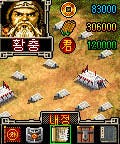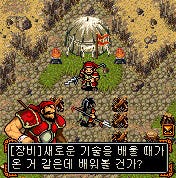President of the Korean mobile developer Gamevil's USA division, Kyu C. Lee discusses the concepts of massively multiplayer mobile games by deconstructing the evolution of Gamevil's hit title, Path of a Warrior, in this exclusive Games On Deck article based on his 2006 GDC Mobile session.

 What is a mobile game? Our company plan has been to focus on what makes a mobile game a "real" mobile game - games which maximize the unique functions of the platform in order to differentiate the mobile experience from other platforms. Such disruptive ideas are what are needed for the mobile games industry.
What is a mobile game? Our company plan has been to focus on what makes a mobile game a "real" mobile game - games which maximize the unique functions of the platform in order to differentiate the mobile experience from other platforms. Such disruptive ideas are what are needed for the mobile games industry.
However, no more one-button games! I've been talking about one button mobile games for a couple of years, and ever since a lot of mobile games that I've seen have really simplified control mechanisms. The games have low technical barriers, but limits within unlimited purchase carrier models - In America, they say venture capitalists are uninterested in the concept. But I think I've talked long enough about that.
It's time to move on. Although Gamevil is known for innovative one button games, another part of our company is that we originally started out as an online gaming company. Since 2004, however, we switched our entire online game department over to mobile. So I thought it would be good to talk about one of our best selling titles these days, Path of a Warrior.
June 3 Kingdoms (2004)
However, to talk about PoW, I have to talk about the product that the team developed prior to its launch, June 3 Kingdoms.
Back in 2003, there was a lot of talk starting about 3G and location based content. SK Telecom adopted a 2.5 generation EVDO service called June, and were looking for content with 3G and LBS functions. Unlimited data services started at a lower monthly rate of $25 for the first time, and before that, we couldn't really develop a connected mobile game due to the high packet fees. But now, our company could jump in immediately to seek the opportunities.
We did several pitches on these types of contents to SK Telecom, and came to a conclusion to develop a LBS RPG game. We had a team with 15 people in it to develop it, which was the largest we had ever had for a mobile game.
Back in those days, RPG online games such as Lineage from NCSoft were a huge success. There were huge activities on communities and especially trading items, and we thought we could make this happen on mobile, so we made a Multiplayer LBS mobile game named June 3 Kingdoms.
The game used the actual city names from Korea, and you could fight against each other to be the owner of a territory. You could declare war against other users, and they would be notified by SMS. The game had more than 100 items which you could trade. The whole game was about running your own country and the object was to unify all the territories available - you could manage the country, raise and train armies, handle diplomatic issues, find talent, and trade.


June 3 Kingdoms
What Went Right
Support from the Carrier
Such a project wasn't possible by our company alone, and SK Telecom funded us with the initial funding to get this project started, and also provided us with ways to work with the LBS capabilities.
Community Building
Of course discussion and Q&As on the large scale of the game started to get people to write about the game online. Additionally, the game's ally system created groups of people to work together to increase the amount of territory that they owned. And finally, the race to get unique items evoked people to brag about such possessions and really started to create an active community.
Web Support
We monitored closely on how the users were playing (or abusing) the game, and observed all the postings on the web sites. As a result, we found out that the people who were playing the game really enjoyed it, but that there was certain limits to the entry of the game.
What Went Wrong
Game Play
People who were familiar with simulation games and were good at using the numbers in a strategic way were the people who enjoyed it. The majority of people thought that the game was too difficult, however.
Handset
You had to have a June handset in order to play the game, which dropped a good 50% of potential users.
Billing Model
You had to be connected to the network from the beginning of the game, which made the users pay enormous amount of money if they didn't have unlimited data.
In the end, it was technically a very innovative and good game, but commercially not a success.
Path of a Warrior (2005)
A true breakout. After we had seen the result of June 3 Kingdoms, we decided to make a sequel, and give it another try. We learned our lesson from the previous launch, and were determined to make a massive success this time. There were a lot of Blockbuster movies being screened in the movie theatres and we thought that we could make a mobile game like this as well.
Gameplay
We decided to make the game easier. Instead of the rather hardcore text based simulation game, we decided to develop an Action RPG, which had more visuals. We simplified the control by making it possible to attack in all directions with one button, and visual effects such as weapons and magic could actually be shown on the screen.
Network
In addition, people were afraid once they saw a network connection being made to the game with June 3 Kingdoms. So we decided to make it optional in the game to connect to the network. We had to take out the LBS function in order to do this, but we made a huge standalone client with 24 endings where the user can grow its characters, plus an optional client where the user could fight against each other. We wanted to educate the users about connected mobile gaming, so we encouraged the user to download the network client by making it easier to gain stats on the connected client, plus we hid special items which you could only achieve in the network client.


Standalone Client (left), Network Client (right)
Billing Model
But we still had a problem with the billing model, which was something that we had to solve with the carrier. With the support of the carrier we made two different price points we could use depending on what data package the user had, and we made them monthly subscriptions. It was a win-win-win for the carrier, publisher and customer.
Community
To increase the community, we realized item trading had a huge part to play. We increased the number of items to 1000, and we made an engineering function in the game to combine certain items to make a new custom item and hid the formulas. People started talking about formulas on how to combine certain items on the web.
We saw more and more people playing each other. And so to keep users playing the game we started adding more clients. We added another client where the user could play "Castle Attack", for example, and these factors really increased the customers' loyalty to the game.
We initially made a bulletin board on our website, but users started gathering on other websites, as they wanted to share their information privately only within their guild. We found out that people were making their own communities on more than 10 different websites.
We also found out that people were starting to sell/buy items online for real money. This is where our service experience online kicked in. Due to the thin client on the handheld we made the server handle a large portion of the game and to handle large amounts of transactions, we developed our server to be a distributed cluster server. Users were matched automatically based on their skills and people could find the exact people to play with using phone numbers. Stability and reliability was important, due to the transactions that the users were making, and the fact that people were trying to hack into their phone in order to find a way around this! With advanced server monitoring, we were able to track and block all the abusers.


Item Screen (left), Castle Attack (right)
Result
As a result of good word of mouth, we succeeded to acheive more than 80,000 subscribers per month after a year of service, with people playing more than 60,000 online sessions per day - around 1,000 people were connected online simultaneously.
After more than a year of service, we had our first user to reach level 400. We did an interview with him, and he was a night worker in his 30s who played the game 5+ hours a day for 14 months. He created his own guild within his workplace, and he said that the additional clients bonded the game and kept him playing.
With PoW, we opened up a whole new age of Mobile Blockbuster Gaming. After our success, games such as Hands-On Mobile's Hero's Lore sprang up and turned out to be a huge successes.
Path of a Warrior 2 (2006)

Path of a Warrior 2
We have launched our new sequel to Path of a Warrior in South Korea. It features 4 additional characters, and we have made the game even larger. We made separate roles of characters to play. We also added additional episodes to play by using microbilling. But if you subscribe to our unlimited episodes, you could get all of this at the same price as the first Path of a Warrior. We have extremely high hopes for the sequel to our blockbusters, and we believe this is the future. We hope the path continues!
[Kyu C. Lee is general manager of Global Business Division at GAMEVIL Inc.(www.gamevil.com), a developer and publisher of mobile games in South Korea. Kyu has been with GAMEVIL since the year 2000, and has played a key role in the evolution of Korean mobile gaming. Kyu graduated Seoul National University with a B.S. in Physics.]
Read more about:
FeaturesAbout the Author(s)
You May Also Like








